Beomeosa Temple In Busan
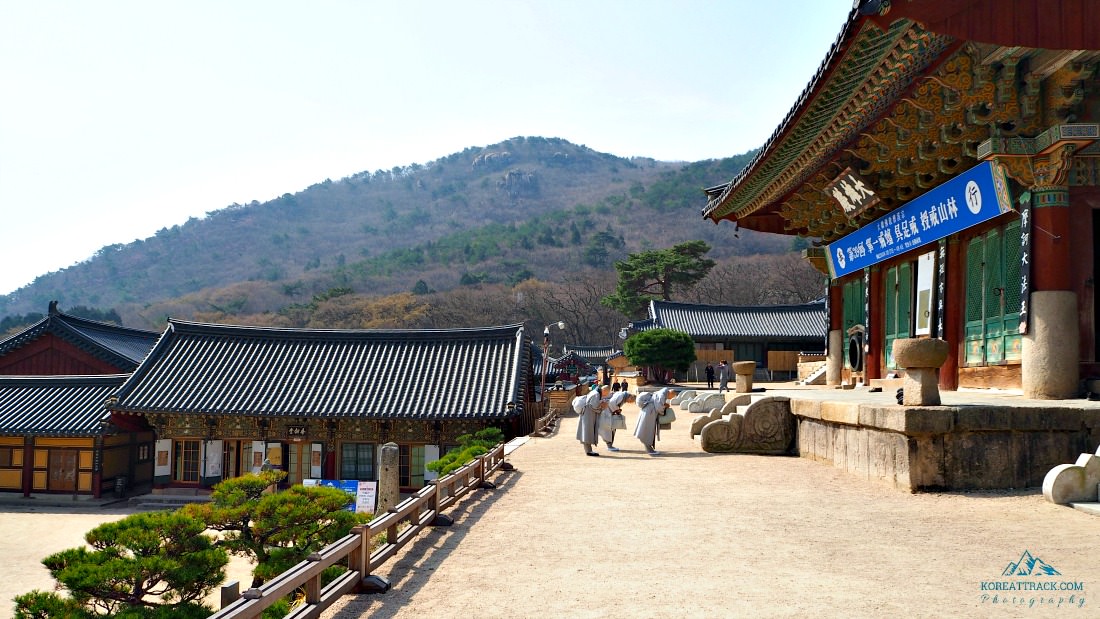 Three Buddhist monks paying respects before the main temple at Beomeosa Temple in Busan City.
Three Buddhist monks paying respects before the main temple at Beomeosa Temple in Busan City.Introduction
Beomeosa Temple in Busan City, South Korea is a popular tourist attraction. It is located at the foot of Geumjeong Mountain and offers spectacular views of the cityscape.
The temple complex includes a number of buildings, including the main hall, Seokgamoni Hall, which enshrines one of Buddha’s disciples; two pagodas; and several stone statuaries.
The temple grounds are also home to a number of ponds, waterfalls and streams, creating a tranquil atmosphere. Visitors can enjoy the beautiful scenery while walking around the complex.
There is also an interesting cultural experience available at the temple: visitors can take part in the “Prayer of Aspiration” ceremony involving chanting and adorning a small “mirror-shaped” paper and burning it as an offering.
The ceremony is believed to help one reach their goals and fulfill their wishes. Beomeosa Temple is a must-see destination for anyone visiting Busan City, South Korea. It showcases the beauty of Korean culture and offers visitors an unforgettable experience.
Visitors leave with a sense of peace and enlightenment, knowing that they have taken part in something truly special. The temple is open all year round, so don’t miss out on the opportunity to explore its beauty and history!
Beomeosa Temple is not only a place of worship, but also an educational hub for visitors. The temple complex provides knowledge about Korean Buddhism and its practices, along with lessons on how to appreciate nature and the environment.
There are plenty of temples within the complex that offer an in-depth look at this beautiful religion, making it an ideal place to learn more about Buddhism.
Beomeosa Temple is also home to a large number of cultural artifacts and relics, including intricately carved statues and scrolls. These pieces are all part of the temple’s history and give visitors a chance to explore the past.
Beyond its spiritual significance and cultural importance, Beomeosa Temple is a great place to just enjoy the beauty of nature. The temple grounds are surrounded by lush vegetation, and visitors can take in stunning views of the nearby mountains and Haeundae Beach.
If you’re looking for a peaceful getaway from reality, Beomeosa Temple is the perfect place to do it.
The temple also hosts various events throughout the year, including traditional Buddhist ceremonies and festivals. There’s always something going on at Beomeosa Temple, so if you’re looking for a unique and exciting way to experience Buddhism in Busan, then make sure to check out these events.
No matter how you choose to experience Beomeosa Temple in Busan City, it’s sure to leave a lasting impression. The atmosphere of the temple is one of serenity and beauty, so make sure to take some time out of your day and come visit this historical landmark in Busan. You won’t regret it!
Beomeosa Temple is also easily accessible from other parts of Busan. It’s located in the northern part of the city, and there are several subway lines that can take you directly to the temple.
Once you arrive, you’ll be surrounded by stunning views of nearby mountains and ocean. In addition, the area is filled with traditional art and crafts for visitors to explore.
Keep on scrolling to find out more...
 Beomeosa Temple's Daeungjeon Hall
Beomeosa Temple's Daeungjeon Halltranquil beomeosa temple
Beomeosa Temple in Busan is one of the most popular and beautiful Buddhist temples tucked in the mountainside of Geumjeongsan, South Korea.
Beomeosa is also one among the three major temples in the country, the others being Haeinsa Temple in Gaya Mountain and Tongdosa Temple in Yangsan.
The temple area is within the forested mountain area with fresh flowing streams that supply water to the resident monks and visitors.
As you enter from the main road, you will be greeted with varied huge rocks in the stream some of which are carved with calligraphy on Buddhism.
Any time of the year, pilgrims, believers, as well as travelers and tourists, come to pray or simply enjoy the serenity of the atmosphere and the beauty of the temples and surroundings.
If you are good at imagining how it looks like in the past, you can picture how the monks move around and do their daily chores while wearing the traditional and rugged-looking ascetic clothing.
The old structures, stone blocks, and ancient stone pillars and lantern are witnesses to the bygone days of the temple's birth, destruction, and restoration.
Getting to Beomeosa Temple is easy. One can take the subway from anywhere in Busan and get off at Beomeosa Temple Station.
A hike or a short bus ride from the station to the temple area is already an exciting activity.
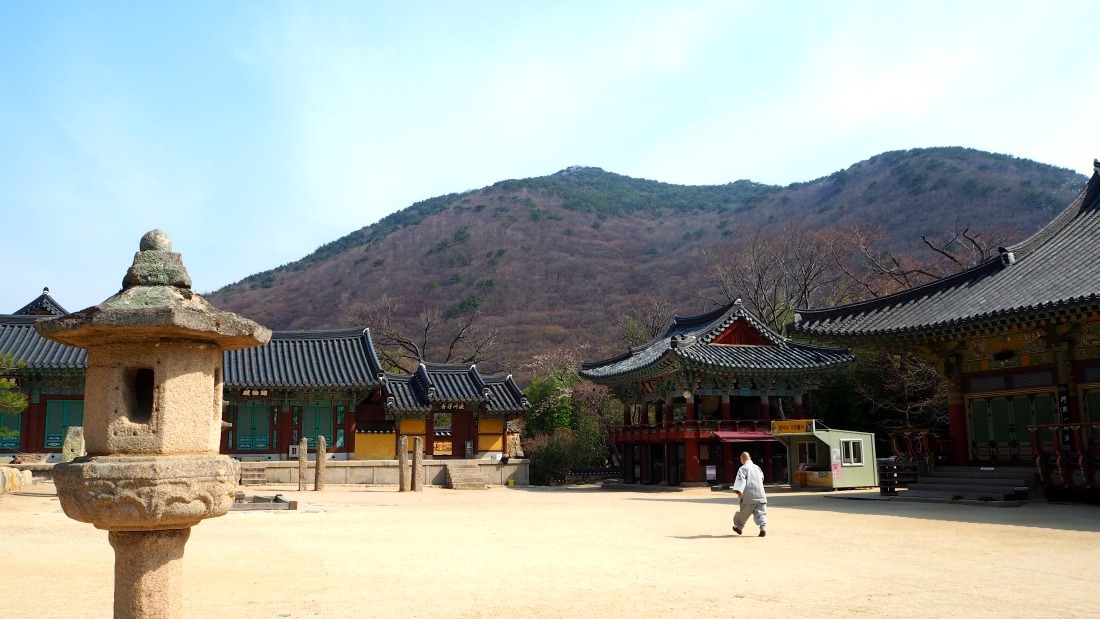 Beomeosa Temple's spacious ground offers an excellent place for people to explore and relax. There are several wooden structures, such as the Main Hall, the Three-story Stone Pagoda, and the Daeungjeon Hall, as well as various stone sculptures scattered throughout the grounds.
Beomeosa Temple's spacious ground offers an excellent place for people to explore and relax. There are several wooden structures, such as the Main Hall, the Three-story Stone Pagoda, and the Daeungjeon Hall, as well as various stone sculptures scattered throughout the grounds.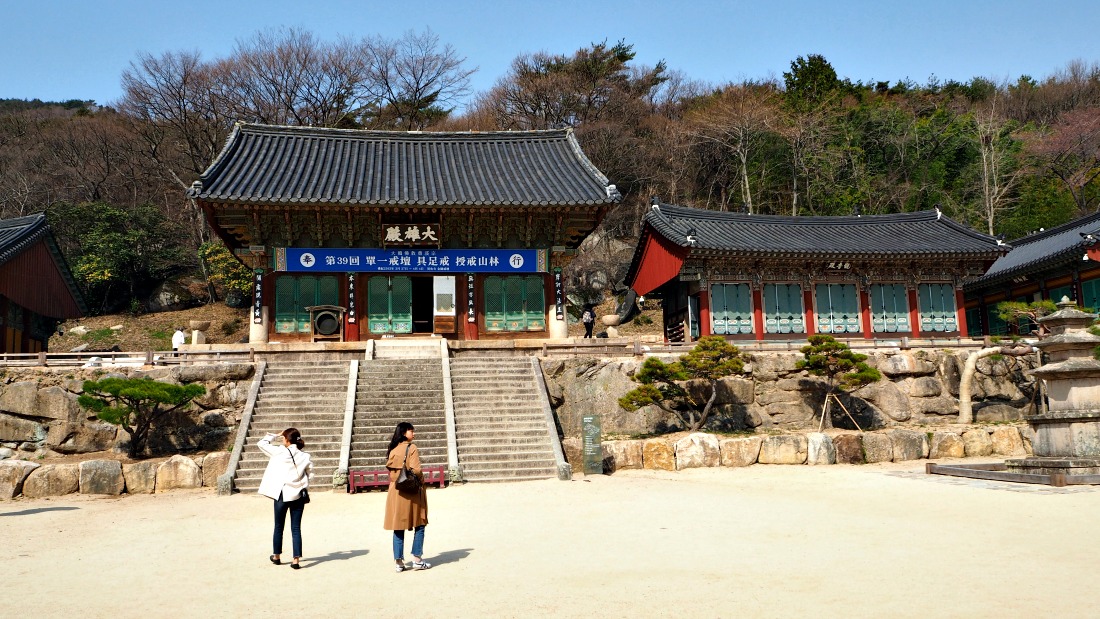 A view of Beomeosa Temple's ground area and main temples
A view of Beomeosa Temple's ground area and main templespersonal experiences
Beomeosa Temple was on top of my list during my Busan visit. Although I was excited to explore other interesting sites and destinations, I know deep inside that Beomeosa is something more than a tourist site.
Yes, my first impressions confirmed my image of this place. It was still a bit chilly, though early in the spring season, I can feel the fresh environment and serene atmosphere of the area.
I was greeted by the pine trees with their sturdy but resilient stature. The streams welcomed my presence with their transparent water and ever-happy sound as they continuously jump downward over rocks.
Upon reaching the temple areas, the Jonggak (bell pavilion), was the closest and first structure I saw.
Among the temple’s structure, the bell pavilion is one of the most important ones as it is composed the Buddhism's religious items, such as the bell.
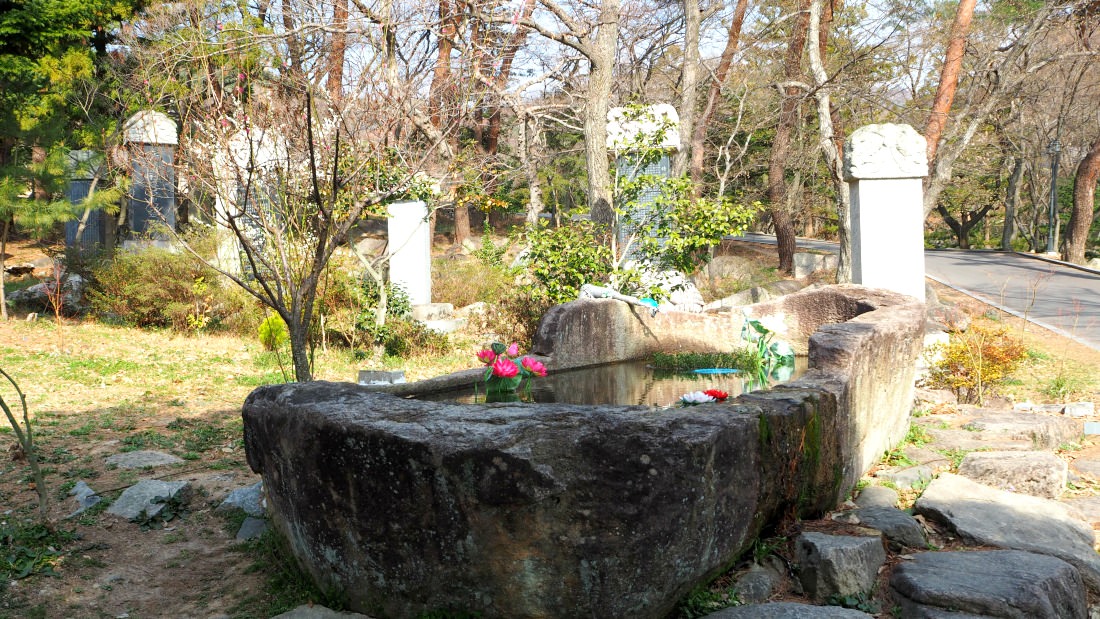 This huge stone water tank contains golden fish (Koi) supporting the legend of the temple's beginning
This huge stone water tank contains golden fish (Koi) supporting the legend of the temple's beginningJust to tell you, I totally enjoyed my visit to the place just as I expected. Maybe more than what I expected. That’s because I have seen more, and have felt or experience enlightening moments I have never expected to happen.
For example, the moment I set foot in the temple area, I felt I became part of its history. I don’t actually fully know what happened in the past, but looking at the relics everywhere was some kind of a blessing.
I touched that old stone lantern and the blocks of dark and old granite stones knowing that they have witnessed the events--both good or bad--in the past. It was an inexpressible moment!
In one of the temple information boards, you will know a brief description of the temple’s history as written below…
Geumjeong ‘Chongrim’ (literally, Comprehensive Training Monastery), Beomeosa Temple was named from the legend which a ‘fish from the Brahma heaven’ (Kor. Beomeo) swam in a “golden well” (Kor. Geumjeong). Beomeosa Temple was built by Great Master Uisang, a leading monk at that time, in the 18th year of King Munmu of the Silla Dynasty (678 C.E.). It is one of the 25 major temples in Korea and has 11 hermitages on the mountain and more than 200 branch temples around the nation. It is also Korea’s major temple of Seon practice as well as a Comprehensive Training Monastery.
what to see
I reckoned that as a vast temple area, there should be more structures and building built in the past before the attacks and destruction occurred in the past.
However, at present, you will find the structures and unique relics as the following...
- Daeungjeon Hall
- Bojeru Pavilion
- Gwaneumjeon Hall
- Jijangjeon Hall
- Palsang, Dokseong, Nahanjeon Halls
- Hyuhyujeongsa (Templestay)
- Birojeon Hall
- Mireukjeon Hall
- Bell Pavilion
- Three-story Story Pagoda
 Three monks paying respects in front of the main temple
Three monks paying respects in front of the main temple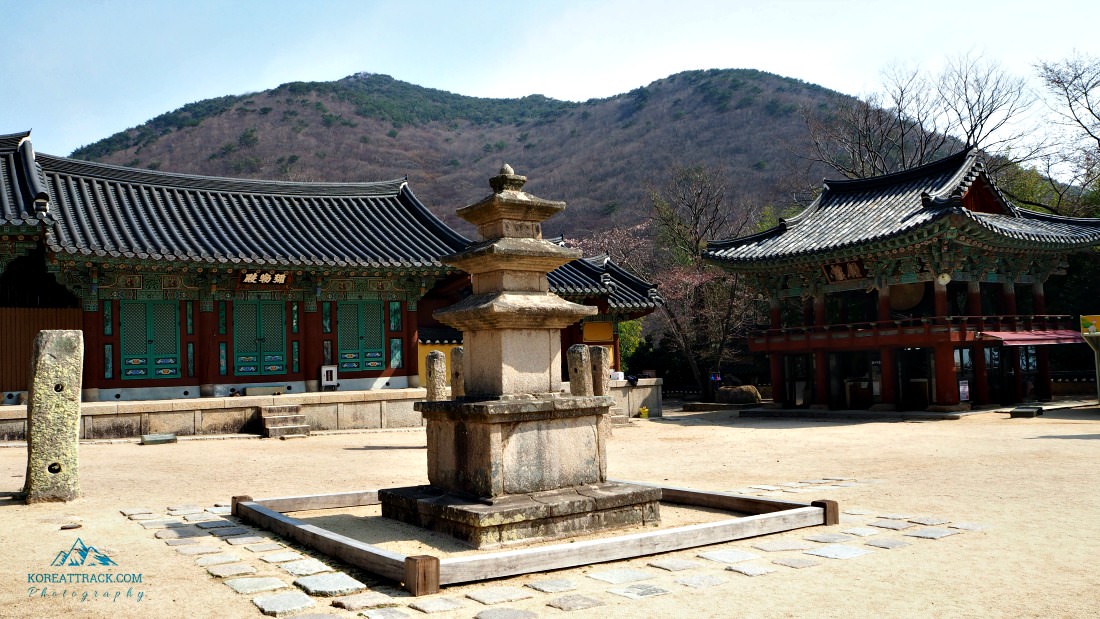 A Three-Story Pagoda in the middle of the themple area
A Three-Story Pagoda in the middle of the themple areaBrief Historical Description
Korea was a target of attacks from various nations trying to expand their territories including China, Mongolia, and Japan.
It was the Japanese invasion in 1592 that caused damage to the temple. Most of the buildings were brought to the ground and reduced to ashes.
This image is sad. However, seeing that much of the destroyed buildings were restored to its present state is remarkable.
It is said that the existing temple structures date back to the 17th and 18th centuries. For example, the second gate of the temple where you can see the four Heavenly Kings (they drive away evils spirits or prevent from coming in) is a replica of the former gate.
That same gate suffered vandalism, and it had to be rebuilt in 2012.
The Chinese monks invented Kung Fu and learned how to defend themselves from attackers.
Similarly, the Korean monks of Beomeosa temple learned and practiced Sunmudo fighting techniques to fight against the invader.
(Sunmudo is a Korean Buddhist form of martial art which is based on ‘seon’ or meditation (‘zen’ in Japanese Buddhism).
That is why it is called “the way of doing meditative martial arts.” The Korean monks also used swords, knives, spears, and throwing stars to defend themselves against the Japanese.)
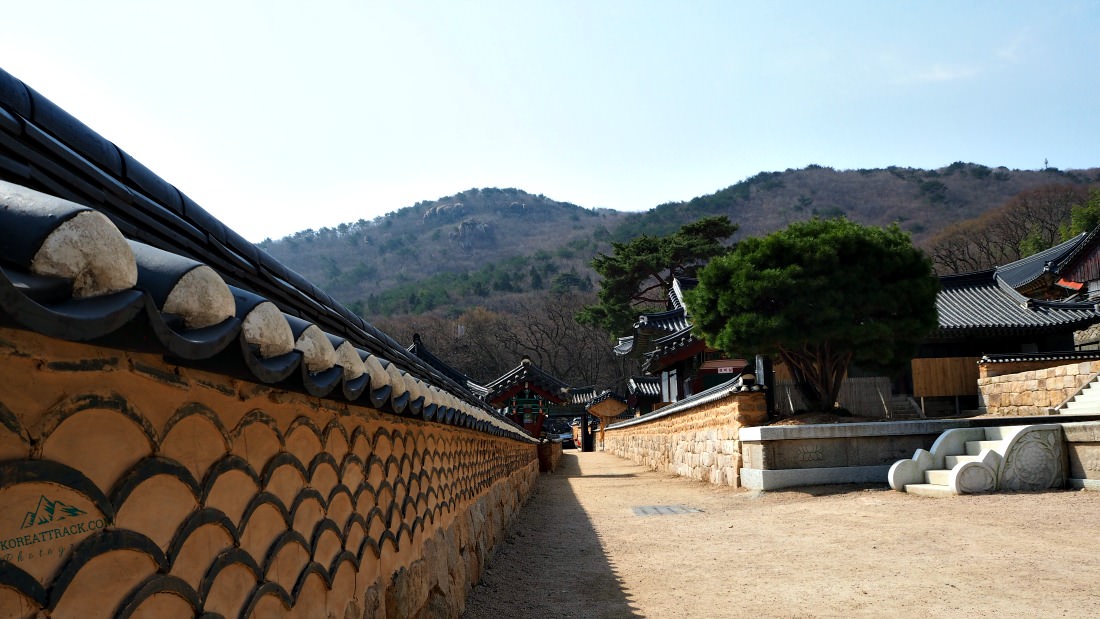 A view of traditional Korean wall at Beomeosa Temple area
A view of traditional Korean wall at Beomeosa Temple areaBeginnings & Legends
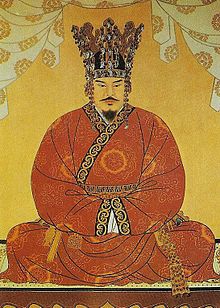 King Munmu
King MunmuBeomeosa Temple in Busan is believed to be founded in 678 C.E. The construction began during the reign of King Munmu of the Silla Dynasty.
During
the 18th year of the king’s reign, real threats and attacks from Japan
occurred. It was during this trying time that King Munmu, as the story
goes, had a dream of a mountain god who told him to go the top of the
mountain.
During his seven days of prayer in solitude, the mountain god (‘sansin’) gave him signs and wisdom on how to repel the enemies.
Coming down from the mountain, he journeyed with a famous monk named Uisang (Uisangdaesa).
King Munmu ordered Uisangdaesa to build Beomeosa as a token of gratitude for helping him defeat the enemies and with god’s help.
The second story (mentioned above) tells of the story of the golden fish that appeared from heaven and made its home in the water of Beomeosa.
It is this story that provides the meanings of the name ‘beomeosa.’ Literally, ‘beom’ means nirvana, ‘eo’ means fish, and ‘sa’ means temple. Ergo, the name ‘beomeosa’ can be literally translated as ‘The Heavenly (Golden) Fish Temple.’
Buildings and Structures
As I mentioned above, there are many temple buildings that you can see and touch. Of course, you may also go in and pay respects or say your prayers.
Shh… remember to keep quiet as they are holy places and others are praying as well.
Also, if you are not a monk, you are expected to go in through either the left or right temple doors. That’s before the central door or entrance is designated only for the monks.
In addition to that, you are expected to keep the basic etiquette while inside the temple area.
Below, are the verbatim descriptions of the buildings you will find in the area...
Gwaneumjeon Hall
The Gwaneumjeon Hall (Lit. Avalokitesvara Hall) is dedicated to Avalokitesvara (lit. “one who looks over the sounds of the world”), the Bodhisattva of Compassion. It is believed that this Bodhisattva in a form with many eyes and hands responds with endless compassion to sentient beings in distress who cry for help by reciting his name with all their might.
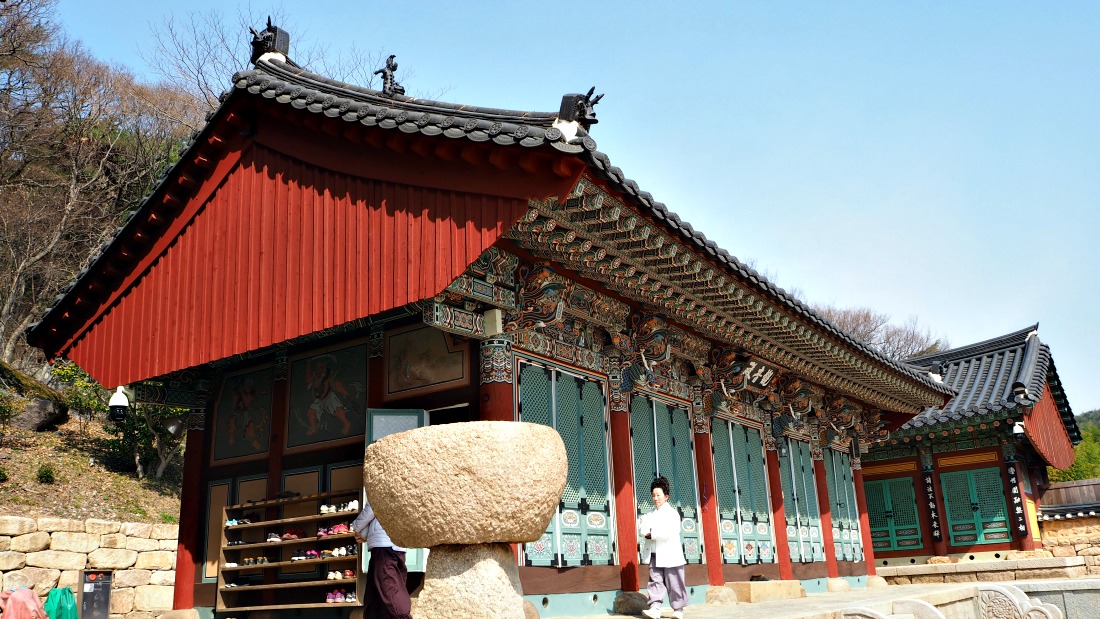 Gwaneumjeon Hall
Gwaneumjeon HallDaeungjeon Hall (대운전) Treasure No. 434 (1966.2.28)
The Daeungjeon Hall (lit. Great Hero Hall) is dedicated to the historical Shakyamuni Buddha. The Daeungjeon Hall at Beomeosa Temple enshrines the Buddhas of Three Periods (Treasure No. 1526). Shakyamuni (Present is flanked by Maitreya (Future) to his left and Dipamkara (Past) to his right, each with an attendant bodhisattva’s statue. It is estimated that the current building was newly built by Venerable Myojeon in 1614.
Palsangjeon, Dokseongjeon, Nahanjeon Halls (Busan Tangible Cultural Property No.63)
This unique style of architecture built by Ven[erable] Hakam in 1906 incorporates three Buddhist shrines: The Palsangjeong, Dokseongjeon, and Nahanjeon Halls. The Palsangjeon Hall enshrines the “Paintings of the Eight Great Events from Shakyamuni Buddha’s Life,” while the Dokseongjeon Hall enshrines Ven.[erable] Nabanm, a hermit who attained enlightenment on his own. The Nahanjeon Hall features Shakyamuni Buddha as the main image with 16 Nahan (nahan: arhat in Sanskrit), or 16 holy disciples, on both sides.
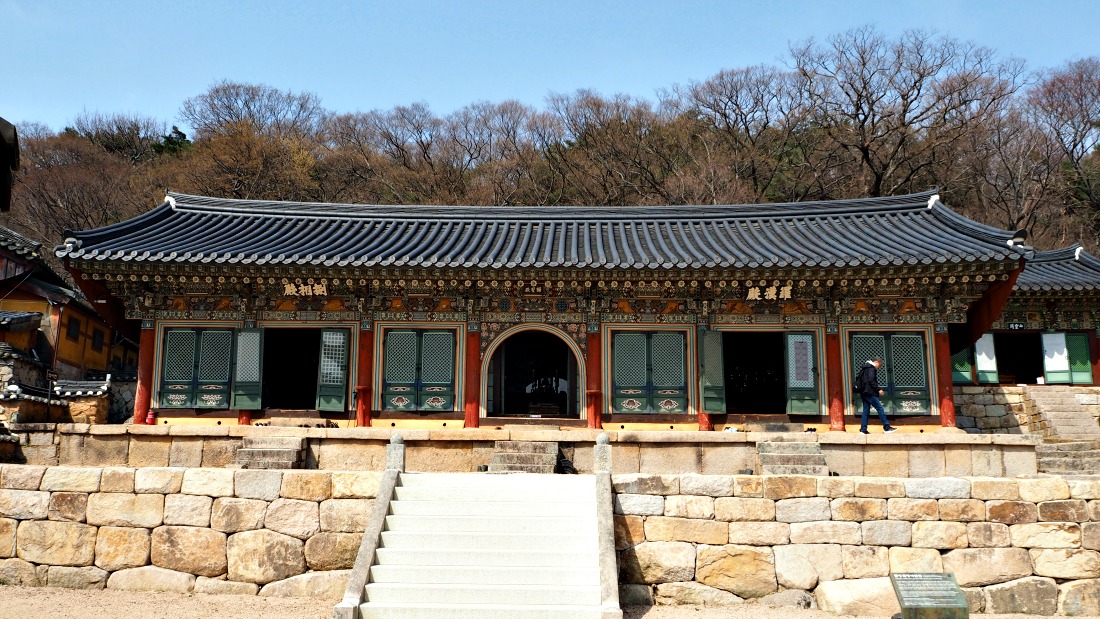 Palsangjeon, Dokseongjeon, Nahanjeon Halls
Palsangjeon, Dokseongjeon, Nahanjeon HallsTemplestay Programme
Since Buddhism was first introduced in Korea, it has served as a spiritual haven for the Korean people for 1,700 years. The Jogye Order has been trying to get closer to the public, opening the doors of mountain temples and providing a first-hand experience of traditional Buddhist culture to domestic and foreign visitors.
Accordingly, Beomeosa Temple is offering a “Temple Stay” program which enables visitors to experience the ascetic life of monks at first, as well a “Temple Life,” which is a one-day program to experience the culture of a Buddhist temple. These programs will provide our contemporaries with the opportunity to escape from the anxieties of daily life, reflect on themselves, and find the way to their real selves.
Experience type/retreat type
Reservations & Inquiries: www.templestay.com / +82-51-508-5726
Other Relics and Treasures
Gingko Tree
As I love nature including trees, the sight of this ancient and towering gingko tree did not escape from my view.
Investigating the looks and everything at the foot of the tree, I found its information board with the following descriptions:
This gingko tree, which is about 580 years old, is reported to have been transplanted by an old Buddhist monk called Myojeon after Imjinwaeran (Japanese Invasion of Jeoseon in 1592). It is also reported that the tree didn’t bear gingko nuts so that the temple decided to plant a male gingko tree on the opposite side about 300 years ago and after that, the tree began to produce about 30 big sacks of gingko nuts each year. In 1990, when the fire was set to make smoke in order to drive away the wasps, it spread to the tree so that the burn marks are still noticeable. This old tree is regarded as a guardian to which a lot of visitors to Beomeosa Temple offer devout prayers and make wishes, so that it deserves to be protected and preserved with love and care.
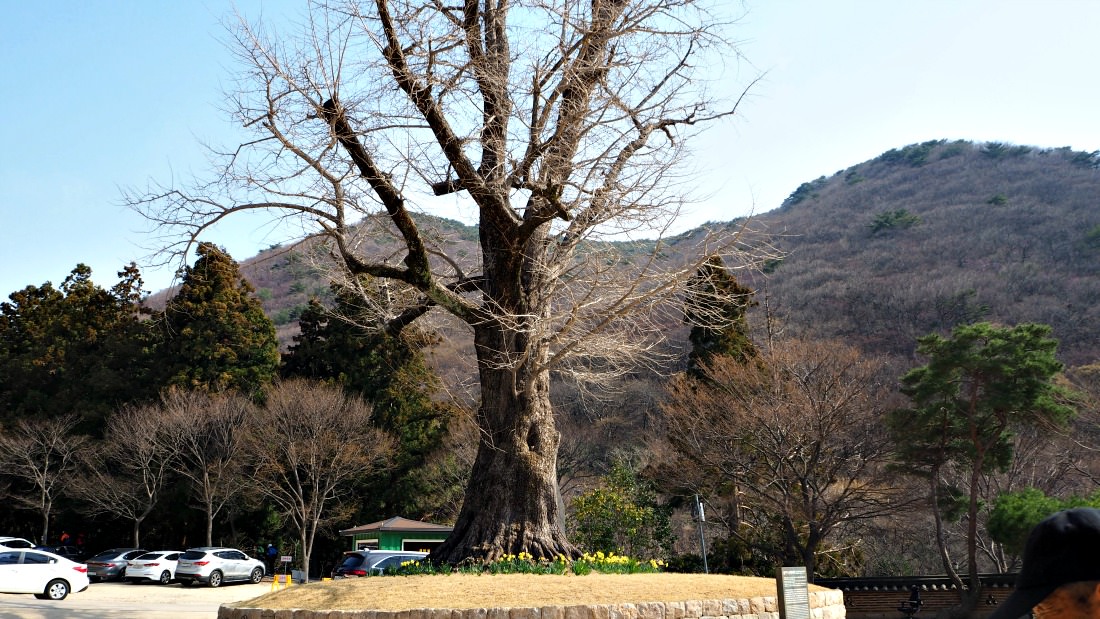 A 580-year-old Gingko Tree at Beomeosa is a standing witness to the events surrounding the temple
A 580-year-old Gingko Tree at Beomeosa is a standing witness to the events surrounding the templeThree-story Stone Pagoda
A pagoda is a unique Buddhist structure which evolved from the stupa to house sarira. Sarira, or Buddhist relics, are usually in the shape of beads left over from Buddha’s cremation. This three-story pagoda at Beomeosa Temple is a typical double based stone pagoda of the Unified Silla period.
 The ancient three-story stone pagoda inside the temple area.
The ancient three-story stone pagoda inside the temple area.Stone Lantern (Busan Tangible Cultural Property No. 16, 1972.6.26)
It would be fascinating to see a stone lantern being lit at night. I couldn't imagine its beauty. However, it is not only a lantern but a symbol of light for all beings as described below…
A stone lantern was built in the yard of a temple to house a lamp. In Buddhism, the lantern symbolizes the light of wisdom that dispels sentient being’s ignorance. The stone lantern is estimated to be work created in the 9th century.
 An old stone lantern used by monks for many centuries until electricity came
An old stone lantern used by monks for many centuries until electricity cameBuddhist Museum
Beomeosa Temple, founded by Great Master Uisang in the 18th year (678 C.E.) of King Munmu’s reign of the Silla Dynasty (57 B.C.E-935.C.E.), boasts a long and rich history and houses many cultural properties. These include 4 Treasures, 30 Tangible Cultural Properties, 31 Cultural Property Materials, and 8 Folklore Materials. The Buddhist Museum (Korean: Seongbo Bangmulgwan) was opened in 2003 to preserve and exhibit sacred Buddhist works.
Opening Hours: 9-5 PM; Lunch Time: 12-1 PM
Closed Days: Every Mondays, Lunar New Year’s Day, Chuseok Holiday
Admission: Free
Just beside the museum, one can also find some relics of old stone words which were supposedly used by monks for their daily activities and chores.
 The museum of Beomeosa preserves and exhibits its treasured relics available for public viewing
The museum of Beomeosa preserves and exhibits its treasured relics available for public viewingOutdoor Relics Exhibition
Beomeosa seven-story pagoda azimuth orientation statue
Beomseosa millstone
Coal of Beomeosa seven-story pagoda
Beomeosa stone mortar
Beomeosa epitaph stone seat
Beomeosa water tank
Beomeosa Buddhist picture stone pillar
Monument designated as Cultural Property
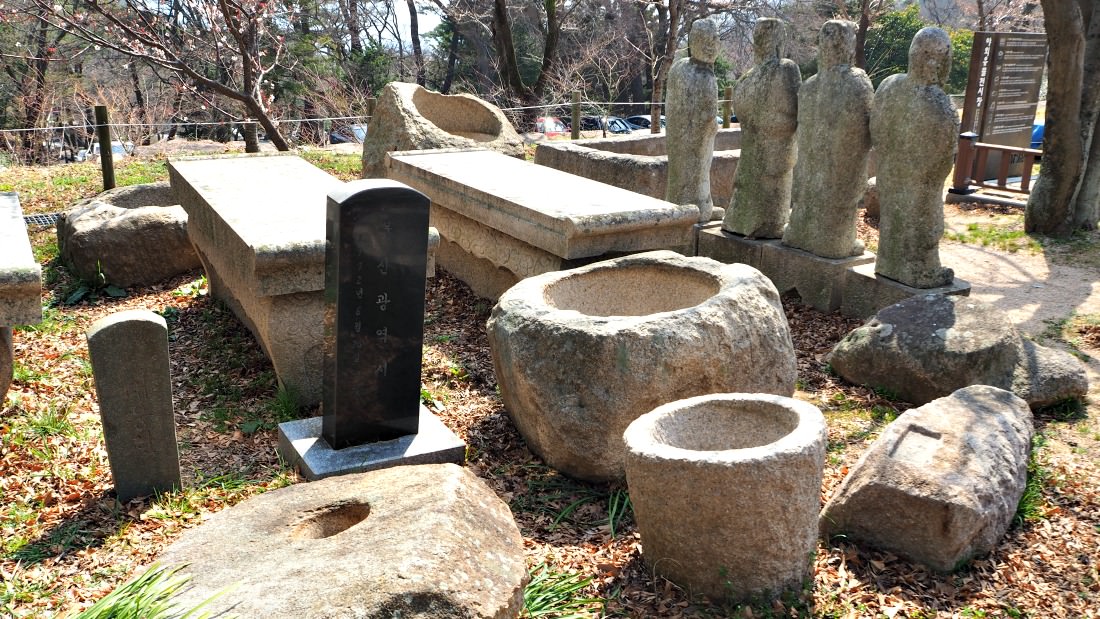 Stone relics at Beomeosa Temple sitting outside the temple museum
Stone relics at Beomeosa Temple sitting outside the temple museumJogyemun Gate - One Pillar Gate
The sight of this gate really excited me. It was my first time to see such a gate. I believe that is one of the originals.
I examined that stone pillars which look really ancient. The way they were sculpted was by using crude tools to created their round shapes. Great job!
Please, read the descriptions of Jogyemun Gate...
The One Pillar gate, or Mountain Gate, is the first of a number of gates built at the entrance to a temple compound. The gate called Jogyemun at Beomeosa Temple is renowned as a masterpiece in Kora with its unique style of supporting the roof with four stone pillars. The gate was called a one pillar gate because when viewed from the side it looks as if one pillar holds up the roof. This gate was first built by Venerable Myojeon in 1614, the 6th year of King Gwanghaegun of the Joseon Dynasty (1392-1910).
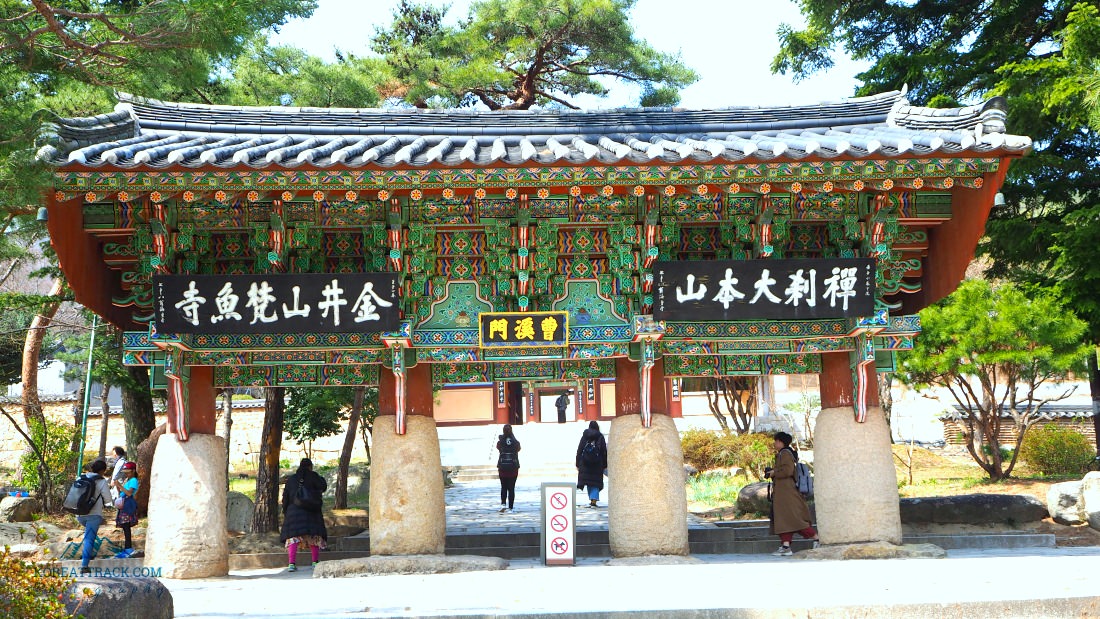 Jogyemun Gate is a unique gate as it has aligned columns which is uncommon in Korean temples
Jogyemun Gate is a unique gate as it has aligned columns which is uncommon in Korean temples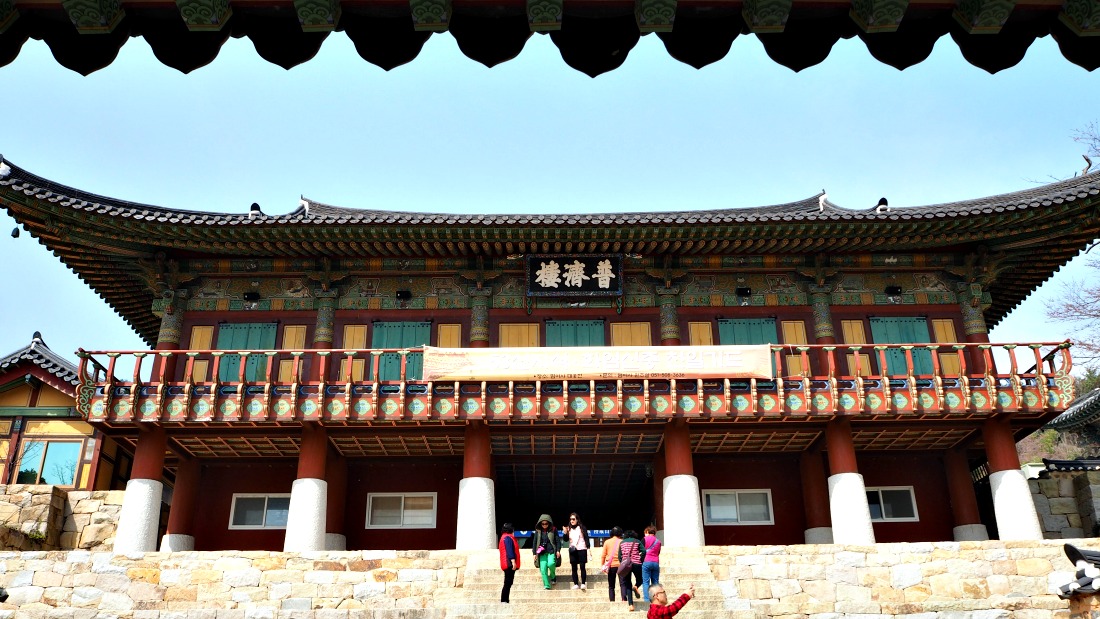 Bojeru Pavilion
Bojeru Pavilion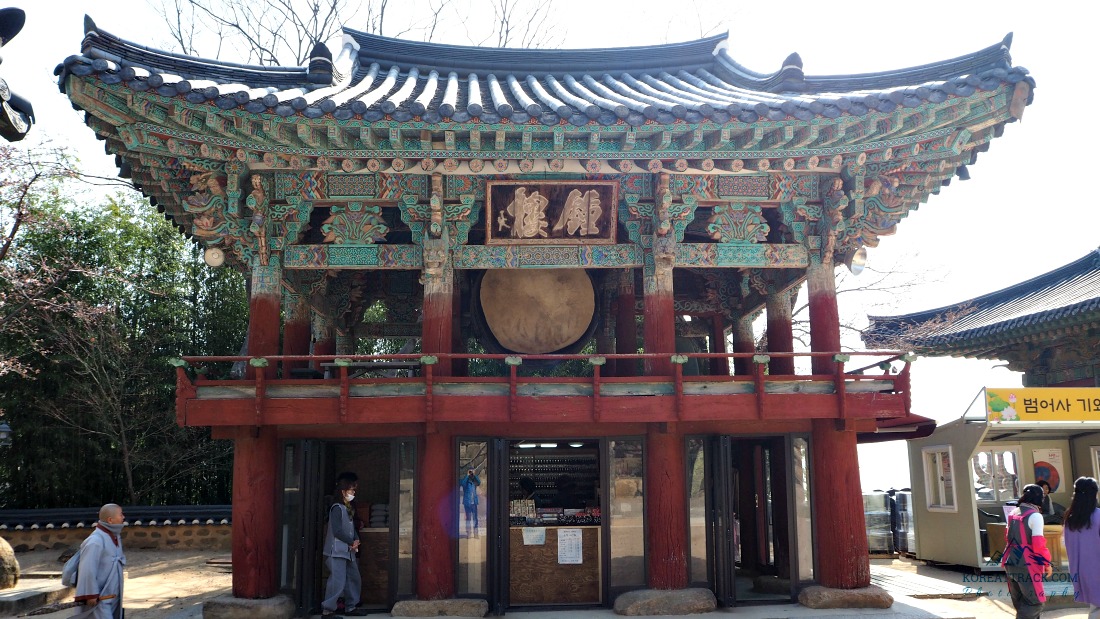 Bell Pavilion
Bell PavilionWhat Else To Do nearby
Besides exploring the beautiful structures and buildings of Beomesa Temple, you have varied opportunities to do nearby.
Some of them are the following...
Hiking Course
If you visit the temple early or before noontime, you can certainly explore the following trail. It says it will take less than three hours to complete the course. Here are the points…
Beomeosa Temple Parking Lot - Naewonam Hermitage - Godangbong Peak - Bukmun (North) Gate - Jeongsuam Hermitage - Sanseong Village (9km, 2hr40min)
Geumjeongsan Mountain
This is precisely where Beomeosa is located. You will see it on the left-hand side of the temple area. It is great for hiking and offers fantastic vistas of Busan.
This mountain was considered to be the reason why this temple was built. It is a conducive area to defend the country from the invaders. So, hike and feel its story.
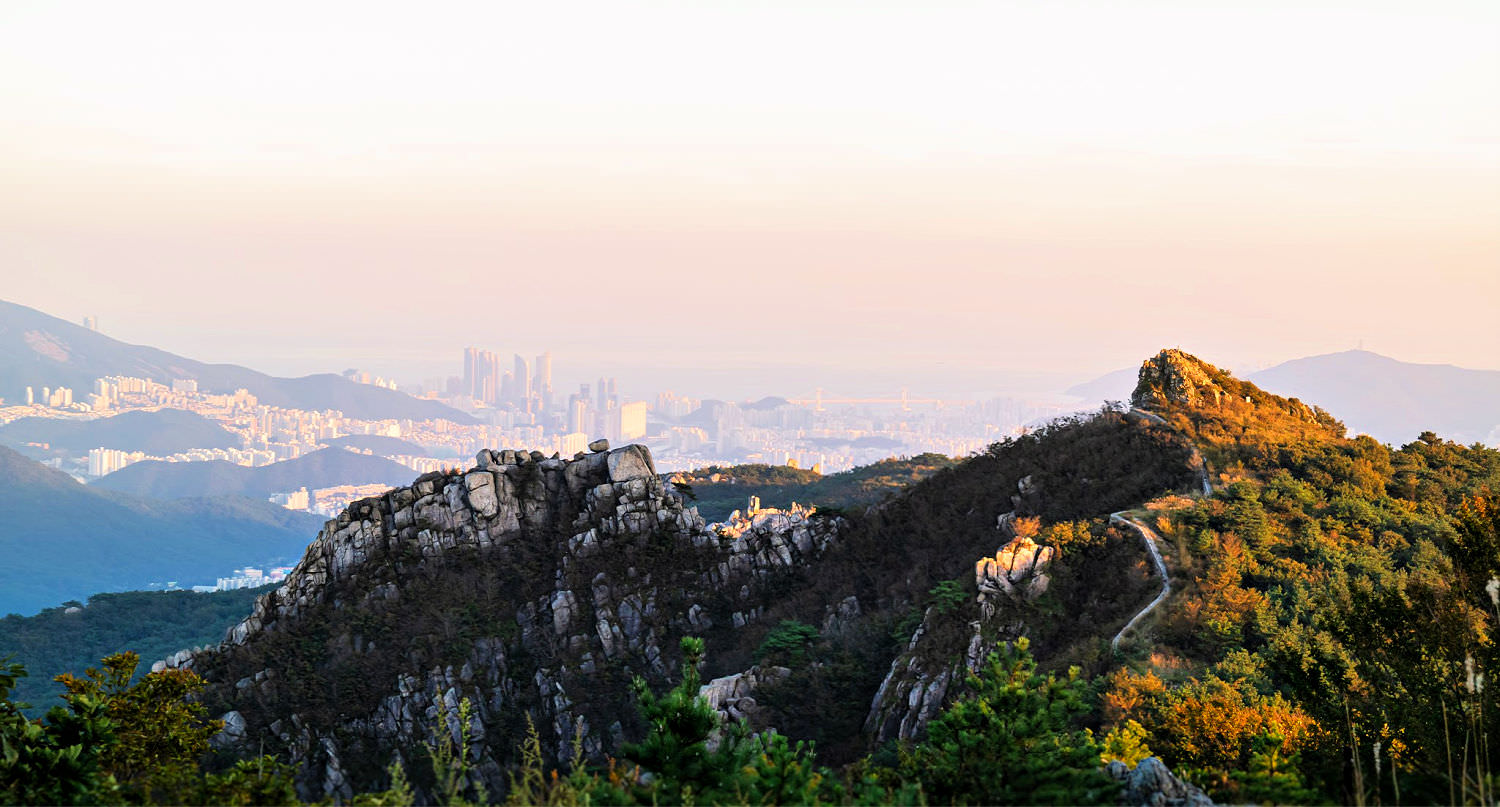 Top of Geumjeongsan Mountain overlooking Busan City
Top of Geumjeongsan Mountain overlooking Busan CityGeumjeongsanseong (Fortress)
At the mountain, you will find the stone walls that were intended to protect the inhabitants from external attacks. This is a mountain fortress, one of the many fortresses built many centuries ago in many Korean mountains.
Hurshimchung Hot Springs
If you love dipping your body into healing hot water, you can also experience them nearby the area. Hurshimchung has varied facilities and hot spring areas for bathing, such as outdoor bath, medicinal baths, longevity baths, among many.
Find more best travel destinations in Busan here.
Getting to Beomeosa Temple
If you are coming to Beomeosa Temple are, you need to take both the Subway and bus. If you want to walk from the subway station to the temple, that is also a great idea as it is a good hiking area.
From anywhere in Busan where you can get the subway, transfer to any connection that will bring you to…
Beomeosa Station (Line No.1), then go to either Exit 5 or Exit 7. Near the exit, find Samsin Transportation Bus Stop.
Take Bus #90. It will take around ten or more minutes to reach the entrance area of Beomeosa Temple.
Taking a Taxi
From Beomosa Station, it will only take around 5 minutes to get to the temple.
Private Vehicles
You may also bring your vehicle near the temple area. I suppose you can park near or outside the temple area.
Contact Details and Address
250, Beomeosa-ro, Geumjeong-gu, Busan
부산광역시 금정구 범어사로 250 (청룡동)
Website: http://www.beomeo.kr/eng_templestay/idt.php
Accommodations Nearby
Yes, there are various types of accommodation near Beomeosa Station but not close to the temple itself.
You can find hotels, pensions, homestays, and guest houses within walking distance of the station. Most of them offer a variety of services such as free wifi, breakfast, laundry facilities, tour packages and so on. I recommend doing your research online to find the best places for you.
Be sure to read reviews and check prices before booking. And remember to book in advance, as accommodation near Beomeosa Station can fill up quickly. Hope this helps! Happy travels! :-)
You can also find a few camping sites located near the temple if you prefer that kind of experience. The area around Beomeosa is very peaceful and beautiful so it's definitely worth exploring.
Make sure to take some time to check out the local attractions and shops, too. You can find traditional markets selling a variety of items including handcrafted goods and souvenirs, as well as plenty of restaurants serving up delicious Korean food. Enjoy your stay! :D
When you're ready to leave Beomeosa Station, you'll have plenty of options for transportation. There are buses, taxis, and even a few rental car companies nearby.
We hope your journey is a memorable one. If you have any questions or need assistance, please don't hesitate to contact us at any time. Have a safe and enjoyable trip!
If you intend to stay closer to the temple area, let me provide you some useful links in case you want to see them.
For more hotels near Beomeosa Station, please see here.
If you want to stay at the famous Haeundae Beach area’s hotel, check out the choices of luxurious and mid-range price hotels at Haeundae Beach Hotels link.
I hope you enjoy and get excited to find more Busan hotels of your choice.
Thanks for reading this article. I hope this is useful. Please, share or like if you do.
- Home
- Temples in South Korea
- Beomeosa Temple
Get Exciting Activities
Book one of our exciting activities today to experience the thrill of a lifetime! Take advantage of this opportunity and secure your spot in advance.
Hotel Map Guide
Find your affordable, accessible, and comfortable hotel in Seoul at Agoda.Com. See the hotel map below...
Hotel Booking Guide
Find affordable and amazing hotels on Agoda.com using the search box below. Book now to enjoy great discounts and save!
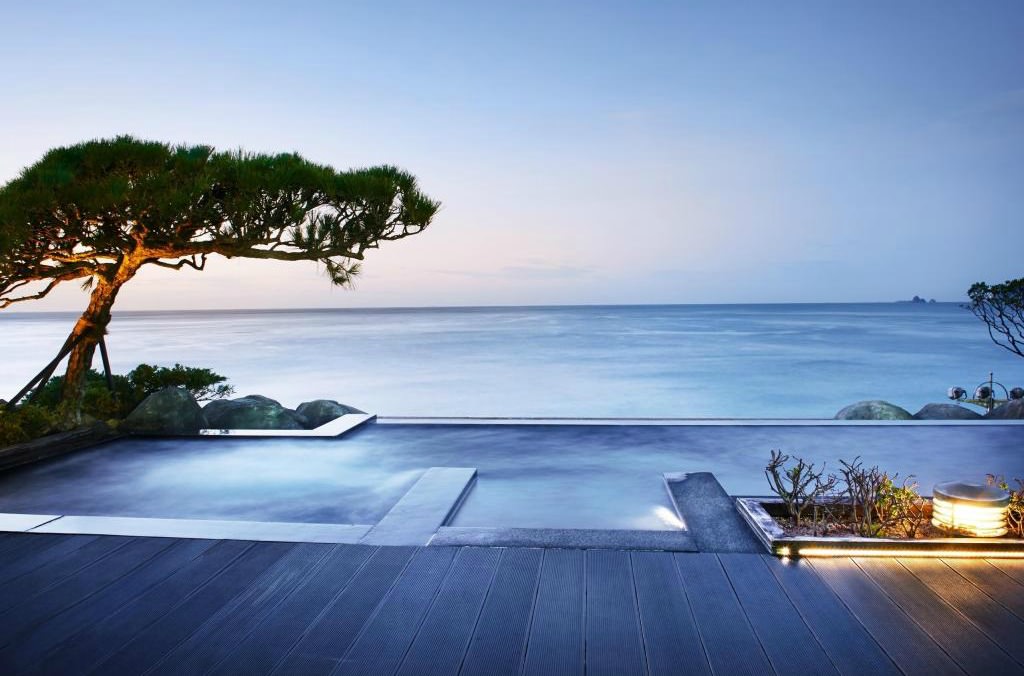
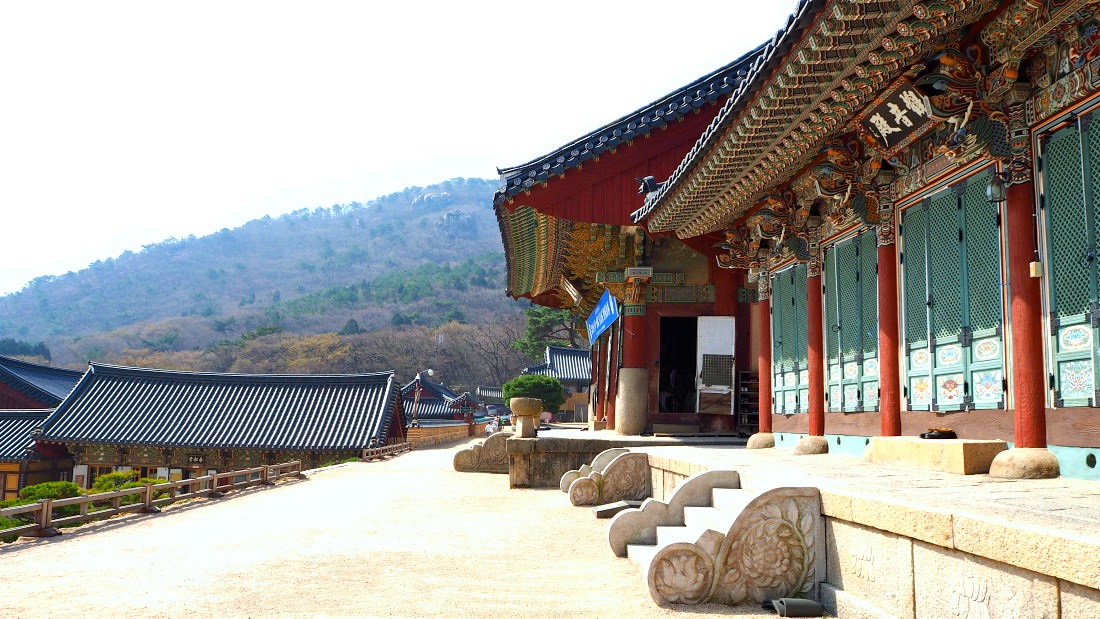

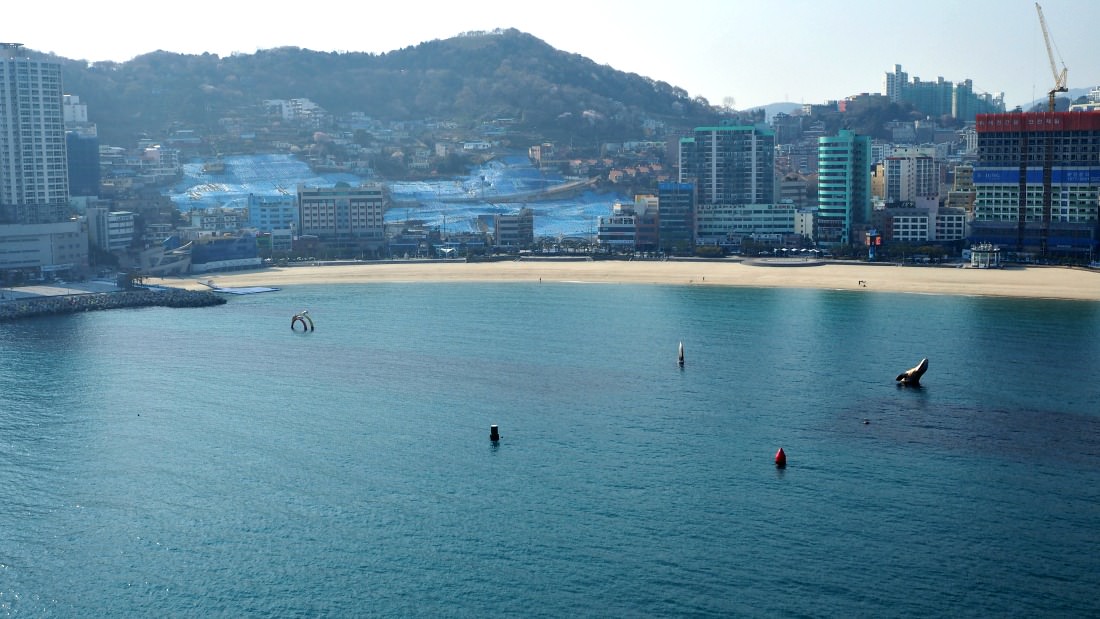




New! Comments
What do you think about this page? Leave me a comment in the box below.